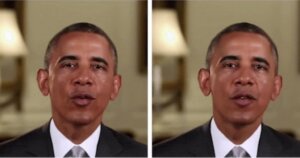Deepfakes, The New Form of Digital Manipulation


Written and verified by the psychologist Valeria Sabater
It looks like witchcraft, but it isn’t. In fact, it’s pure engineering of the future, an artificial intelligence device worthy of inclusion in the books of Arthur C. Clarke. Deepfakes are those videos that are digitally altered and that allow you to change the face of one person for another. The result is so perfect that you can depict anyone saying or doing anything that they never actually said or did.
Most use this resource for making jokes with their friends and family. After all, who hasn’t put their face onto that of a celebrity like Lady Gaga, Leonardo DiCaprio, Captain America, and Scarlett Johansson, etc. In such a way, that you suddenly find yourself dancing in a music video or starring in a clip from a famous movie.
However, this technology can be used both for innocuous and criminal purposes. An example of the latter is that of Raffaela Spone, a 50-year-old woman living in a town in Pennsylvania. This housewife launched a smear campaign against three members of her daughter’s cheerleader team. In fact, she created incriminating fake images of the girls and distributed them.
Ms. Spone was arrested and charged with cyberbullying minors. Her manipulated photos were distributed by the school and social networks. However, fortunately, the police were aware that they’d been created with artificial intelligence technology.
Another example is a video of Obama that circulated on YouTube in which he said that Donald Trump was an idiot. It generated a great media controversy. In reality, it wasn’t true, but was, in fact, an experiment by the University of Washington. However, it demonstrated the effects that the manipulation of videos through an artificial intelligence algorithm is able to produce.

Deepfakes and the importance of critical thinking
Deepfakes are in fashion. Putting the face of one person on the body of another to say or do something is, indeed, pretty ingenious. In fact, urban legend says that if you say the word deepfake three times, Tom Cruise will appear.
However, the University of Victoria (Canada), the Nottingham Trent University (United Kingdom), and the LUISS Guido Carli University (Italy) conducted research that claims photographic manipulation is something that’s been done since the 19th century.
Nevertheless, the arrival of deepfakes has marked a turning point in this phenomenon. Because in many cases, they’re used for criminal purposes, such as pornography, fake news, and financial fraud. In fact, the problem’s become so serious, that new laws are to be implemented in the near future.
In this digital age, deception, whether through false news or images, is the order of the day. Furthermore, its social impact is enormous. Therefore, we must be prepared to detect these manipulative devices.
When the image has more power than words (and the truth)
It’s easier to believe what you see than what you’re told. Deepfakes alter the truth by manipulating visual documents. One example occurred in Venice during the pandemic. Images of black swans moving calmly through the water of the canals were published.
We also saw strangely shaped fish in the flooded streets. However, none of it was true. The swans were the product of artificial intelligence. Indeed, in the world of misinformation, deepfakes are a great ally.
Pornographic content and deepfakes
Deepfake technology is often used as a means of harassment and revenge. For these kinds of behavior, what could be better than creating pornographic videos? In fact, people simply choose a clip and place the face of whoever they want on it.
Then comes the next step, distributing it. As a matter of fact, pornographic videos created with deepfake technology are used in school and work settings. It’s a highly effective form of harassment.
The hacking of reality
Deepfakes emerged in 2007, a little before fake news became the order of the day. At present, all these trends are hacking and tampering with our reality. They’re used in smear campaigns to attack public figures. What’s more, according to a publication in the Crime Science Journal, deepfakes for criminal purposes involve huge amounts of money each year.
It’s estimated that there may be currently more than 50,000 deepfakes circulating on the internet. Furthermore, we’re giving credence to many of them.

What can we do about this type of technology?
Countries like China have banned the use of this type of artificial intelligence. Also, Facebook has created a fund of more than ten million dollars with the intention of generating tools to protect the population against their misuse. Microsoft, for example, proposes that we use its Video Authenticator to find out if a video or an image has been manipulated.
We have two final comments to make on this subject. Firstly, you should never resort to this type of technology for the purposes of harassment or revenge. Secondly, you need to develop the skill of critical thinking with which to approach these kinds of messages. Because, in a world in which reality is increasingly manipulated, only a filter of caution can protect you …
It looks like witchcraft, but it isn’t. In fact, it’s pure engineering of the future, an artificial intelligence device worthy of inclusion in the books of Arthur C. Clarke. Deepfakes are those videos that are digitally altered and that allow you to change the face of one person for another. The result is so perfect that you can depict anyone saying or doing anything that they never actually said or did.
Most use this resource for making jokes with their friends and family. After all, who hasn’t put their face onto that of a celebrity like Lady Gaga, Leonardo DiCaprio, Captain America, and Scarlett Johansson, etc. In such a way, that you suddenly find yourself dancing in a music video or starring in a clip from a famous movie.
However, this technology can be used both for innocuous and criminal purposes. An example of the latter is that of Raffaela Spone, a 50-year-old woman living in a town in Pennsylvania. This housewife launched a smear campaign against three members of her daughter’s cheerleader team. In fact, she created incriminating fake images of the girls and distributed them.
Ms. Spone was arrested and charged with cyberbullying minors. Her manipulated photos were distributed by the school and social networks. However, fortunately, the police were aware that they’d been created with artificial intelligence technology.
Another example is a video of Obama that circulated on YouTube in which he said that Donald Trump was an idiot. It generated a great media controversy. In reality, it wasn’t true, but was, in fact, an experiment by the University of Washington. However, it demonstrated the effects that the manipulation of videos through an artificial intelligence algorithm is able to produce.

Deepfakes and the importance of critical thinking
Deepfakes are in fashion. Putting the face of one person on the body of another to say or do something is, indeed, pretty ingenious. In fact, urban legend says that if you say the word deepfake three times, Tom Cruise will appear.
However, the University of Victoria (Canada), the Nottingham Trent University (United Kingdom), and the LUISS Guido Carli University (Italy) conducted research that claims photographic manipulation is something that’s been done since the 19th century.
Nevertheless, the arrival of deepfakes has marked a turning point in this phenomenon. Because in many cases, they’re used for criminal purposes, such as pornography, fake news, and financial fraud. In fact, the problem’s become so serious, that new laws are to be implemented in the near future.
In this digital age, deception, whether through false news or images, is the order of the day. Furthermore, its social impact is enormous. Therefore, we must be prepared to detect these manipulative devices.
When the image has more power than words (and the truth)
It’s easier to believe what you see than what you’re told. Deepfakes alter the truth by manipulating visual documents. One example occurred in Venice during the pandemic. Images of black swans moving calmly through the water of the canals were published.
We also saw strangely shaped fish in the flooded streets. However, none of it was true. The swans were the product of artificial intelligence. Indeed, in the world of misinformation, deepfakes are a great ally.
Pornographic content and deepfakes
Deepfake technology is often used as a means of harassment and revenge. For these kinds of behavior, what could be better than creating pornographic videos? In fact, people simply choose a clip and place the face of whoever they want on it.
Then comes the next step, distributing it. As a matter of fact, pornographic videos created with deepfake technology are used in school and work settings. It’s a highly effective form of harassment.
The hacking of reality
Deepfakes emerged in 2007, a little before fake news became the order of the day. At present, all these trends are hacking and tampering with our reality. They’re used in smear campaigns to attack public figures. What’s more, according to a publication in the Crime Science Journal, deepfakes for criminal purposes involve huge amounts of money each year.
It’s estimated that there may be currently more than 50,000 deepfakes circulating on the internet. Furthermore, we’re giving credence to many of them.

What can we do about this type of technology?
Countries like China have banned the use of this type of artificial intelligence. Also, Facebook has created a fund of more than ten million dollars with the intention of generating tools to protect the population against their misuse. Microsoft, for example, proposes that we use its Video Authenticator to find out if a video or an image has been manipulated.
We have two final comments to make on this subject. Firstly, you should never resort to this type of technology for the purposes of harassment or revenge. Secondly, you need to develop the skill of critical thinking with which to approach these kinds of messages. Because, in a world in which reality is increasingly manipulated, only a filter of caution can protect you …
All cited sources were thoroughly reviewed by our team to ensure their quality, reliability, currency, and validity. The bibliography of this article was considered reliable and of academic or scientific accuracy.
- Nguyen, Thanh & Nguyen, Cuong M. & Nguyen, Tien & Nguyen, Duc & Nahavandi, Saeid. (2019). Deep Learning for Deepfakes Creation and Detection: A Survey.
- Kietzmann, J.; Lee, L. W.; McCarthy, I. P.; Kietzmann, T. C. (2020). “Deepfakes: Trick or treat?”. Business Horizons. 63 (2): 135–146. doi:10.1016/j.bushor.2019.11.006
- Roose, Kevin (4 March 2018). “Here Come the Fake Videos, Too”. The New York Times. ISSN 0362-4331
This text is provided for informational purposes only and does not replace consultation with a professional. If in doubt, consult your specialist.







